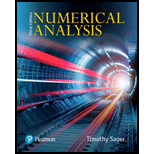
Numerical Analysis
3rd Edition
ISBN: 9780134696454
Author: Sauer, Tim
Publisher: Pearson,
expand_more
expand_more
format_list_bulleted
Concept explainers
Textbook Question
Chapter 0.3, Problem 8E
Is
Expert Solution & Answer
Want to see the full answer?
Check out a sample textbook solution
Students have asked these similar questions
In each of the following you are given a bit sequencecorresponding to the IEEE single precisionrepresentation of a floating-point number. In eachcase determine the base 2 floating-point representationof the number and also the base 10 decimalrepresentation of the number: 11000100010010000000000000000000
Show that 2047 is a strong pseudoprime to the base 2 by showing that it passes Miller’s test to the base 2, but is composite.
What would the machine epsilon be for a computer that uses 36-digit base 2 floating-point arithmetic?
Chapter 0 Solutions
Numerical Analysis
Ch. 0.1 - Rewrite the following polynomials in nested form...Ch. 0.1 - Rewrite the following polynomials in nested form...Ch. 0.1 - Evaluate P(x)=x64x4+2x2+1 at x=1/2 by considering...Ch. 0.1 - Evaluate the nested polynomial with base points...Ch. 0.1 - Evaluate the nested polynomial with base points...Ch. 0.1 - Explain how to evaluate the polynomial for a given...Ch. 0.1 - How many additions and multiplications are...Ch. 0.1 - Use the function nest to evaluate P(x)=1+x+...+x50...Ch. 0.1 - Use nest.m to evaluate P(x)=1x+x2x3+...+x98x99 at...Ch. 0.2 - Find the binary representation of the base 10...
Ch. 0.2 - Find the binary representation of the base 10...Ch. 0.2 - Convert the following base 10 numbers to binary....Ch. 0.2 - Convert the following base 10 numbers to binary....Ch. 0.2 - Find the first bits in the binary representation...Ch. 0.2 - Find the first 15 bits in the binary...Ch. 0.2 - Convert the following binary numbers to base :...Ch. 0.2 - Convert the following binary numbers to base...Ch. 0.3 - Convert the following base 10 numbers to binary...Ch. 0.3 - Convert the following base 10 numbers to binary...Ch. 0.3 - For which positive integers k can the number 5+2k...Ch. 0.3 - Find the largest integer k for which in double...Ch. 0.3 - Do the following sums by hand in IEEE double...Ch. 0.3 - Do the following sums by hand in IEEE double...Ch. 0.3 - Prob. 7ECh. 0.3 - Is 1/3+2/3 exactly equal to I in double precision...Ch. 0.3 - Prob. 9ECh. 0.3 - Prob. 10ECh. 0.3 - Does the associative law hold for IEEE computer...Ch. 0.3 - Prob. 12ECh. 0.3 - Prob. 13ECh. 0.3 - Prob. 14ECh. 0.3 - Do the following operations by hand in IEEE double...Ch. 0.3 - Prob. 16ECh. 0.4 - Identify for which values of x there is...Ch. 0.4 - Find the roots of the equation x2+3x814=0 with...Ch. 0.4 - Explain how to most accurately compute the two...Ch. 0.4 - Evaluate the quantity xx2+17x2 where x=910 ,...Ch. 0.4 - Evaluate the quantity 16x4x24x2 where x=812 ,...Ch. 0.4 - Prove formula (0.14).Ch. 0.4 - Calculate the expressions that follow in double...Ch. 0.4 - Prob. 2CPCh. 0.4 - Prob. 3CPCh. 0.4 - Prob. 4CPCh. 0.4 - Prob. 5CPCh. 0.5 - Prob. 1ECh. 0.5 - Find c satisfying the Mean Value Theorem for f(x)...Ch. 0.5 - Find c satisfying the Mean Value Theorem for...Ch. 0.5 - Find the Taylor polynomial of degree 2 about the...Ch. 0.5 - Find the Taylor polynomial of degree 5 about the...Ch. 0.5 - a. Find the Taylor polynomial of degree 4 for ...Ch. 0.5 - Carry out Exercise 6 (a)-(d) for f(x)=lnx .Ch. 0.5 - (a) Find the degree 5 Taylor polynomial centered...Ch. 0.5 - Prob. 9E
Knowledge Booster
Learn more about
Need a deep-dive on the concept behind this application? Look no further. Learn more about this topic, subject and related others by exploring similar questions and additional content below.Similar questions
- Suppose that the check digit is computed as described in Example . Prove that transposition errors of adjacent digits will not be detected unless one of the digits is the check digit. Example Using Check Digits Many companies use check digits for security purposes or for error detection. For example, an the digit may be appended to a -bit identification number to obtain the -digit invoice number of the form where the th bit, , is the check digit, computed as . If congruence modulo is used, then the check digit for an identification number . Thus the complete correct invoice number would appear as . If the invoice number were used instead and checked, an error would be detected, since .arrow_forwardSuppose 4- bit words abcd are mapped onto 5- bit code words abcde, where e is the parity check digit. Detect any errors in the following six-word coded message. 111010010100010111000001110100arrow_forwardUse Pascal’s Triangle to expand (2x3)4.arrow_forward
Recommended textbooks for you
- Algebra & Trigonometry with Analytic GeometryAlgebraISBN:9781133382119Author:SwokowskiPublisher:Cengage
 Elements Of Modern AlgebraAlgebraISBN:9781285463230Author:Gilbert, Linda, JimmiePublisher:Cengage Learning,
Elements Of Modern AlgebraAlgebraISBN:9781285463230Author:Gilbert, Linda, JimmiePublisher:Cengage Learning, Algebra for College StudentsAlgebraISBN:9781285195780Author:Jerome E. Kaufmann, Karen L. SchwittersPublisher:Cengage Learning
Algebra for College StudentsAlgebraISBN:9781285195780Author:Jerome E. Kaufmann, Karen L. SchwittersPublisher:Cengage Learning 

Algebra & Trigonometry with Analytic Geometry
Algebra
ISBN:9781133382119
Author:Swokowski
Publisher:Cengage

Elements Of Modern Algebra
Algebra
ISBN:9781285463230
Author:Gilbert, Linda, Jimmie
Publisher:Cengage Learning,

Algebra for College Students
Algebra
ISBN:9781285195780
Author:Jerome E. Kaufmann, Karen L. Schwitters
Publisher:Cengage Learning

Sequences and Series Introduction; Author: Mario's Math Tutoring;https://www.youtube.com/watch?v=m5Yn4BdpOV0;License: Standard YouTube License, CC-BY
Introduction to sequences; Author: Dr. Trefor Bazett;https://www.youtube.com/watch?v=VG9ft4_dK24;License: Standard YouTube License, CC-BY